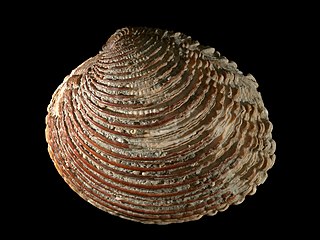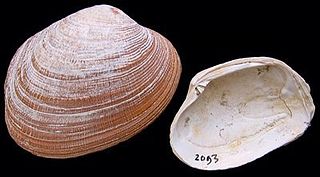Related Research Articles

Clam is a common name for several kinds of bivalve molluscs. The word is often applied only to those that are edible and live as infauna, spending most of their lives halfway buried in the sand of the seafloor or riverbeds. Clams have two shells of equal size connected by two adductor muscles and have a powerful burrowing foot. They live in both freshwater and marine environments; in salt water they prefer to burrow down into the mud and the turbidity of the water required varies with species and location; the greatest diversity of these is in North America.
Perkinsus is a genus of alveolates in the phylum Perkinsozoa. The genus was erected in 1978 to better treat its type species, Perkinsus marinus, known formerly as Dermocystidium marinum. These are parasitic protozoans that infect molluscs, at least some of which cause disease and mass mortality. P. marinus is the most notorious, causing the disease perkinsosis, or dermo, in wild and farmed oysters.

The Veneridae or venerids, common name: Venus clams, are a very large family of minute to large, saltwater clams, marine bivalve molluscs. Over 500 living species of venerid bivalves are known, most of which are edible, and many of which are exploited as food sources.

Fanny Bay is a small hamlet in the Canadian province of British Columbia. It is located on Baynes Sound on the east coast of Vancouver Island. In 2001, its population was listed as 815. It is best known for its fine oysters.

The grooved carpet shell, or Palourde clam, Ruditapes decussatus, or Venerupis decussatus, is a clam in the family Veneridae. It is distributed worldwide and due to its ecological and economic interest has been proposed as a bioindicator.

Austrovenus stutchburyi, common name the New Zealand cockle or New Zealand little neck clam, is an edible saltwater clam, a marine bivalve mollusc in the family Veneridae, the Venus clams. Its Māori name is tuangi or tuaki.

Venerupis corrugata, the pullet carpet shell, is a species of bivalve mollusc in the family Veneridae. It is found buried in the sediment on the sea bed in shallow parts of the eastern Atlantic Ocean. It is harvested for human consumption in Spain and other parts of Western Europe.
Arcobacter bivalviorum is a species of Gram-negative, slightly curved, motile, rod-shaped bacteria first recovered from mussels and clams. Its type strain is F67-11(T)=CECT 7836(T)=LMG 26156(T)).
Arcobacter venerupis is a species of Gram-negative, slightly curved motile rod-shaped bacteria. It was first recovered from mussels and clams. Its type strain is F4(T)=CECT 7835(T)=LMG 26154(T)).

Corbicula japonica is an edible species of brackishwater clam, a bivalve mollusk in the family Cyrenidae, the basket clams.
Lacinutrix algicola is a Gram-negative, aerobic and heterotrophic bacterium from the genus of Lacinutrix which has been isolated from a red alga.
Lacinutrix chionocetis is a Gram-negative, aerobic, rod-shaped and non-motile bacterium from the genus of Lacinutrix which has been isolated from the gut of a red snow crab.
Lacinutrix cladophorae is a Gram-negative, strictly aerobic, rod-shaped and motile bacterium from the genus of Lacinutrix which has been isolated from the alga Cladophora stimpsonii.
Lacinutrix copepodicola is a bacterium from the genus of Lacinutrix.
Lacinutrix gracilariae is a Gram-negative, aerobic and rod-shaped bacterium from the genus of Lacinutrix which has been isolated from the alga Gracilaria sp.
Lacinutrix himadriensis is a Gram-negative, rod-shaped, psychrophilic and non-motile bacterium from the genus of Lacinutrix.
Lacinutrix salivirga is a Gram-negative, strictly aerobic, rod-shaped and motile bacterium from the genus of Lacinutrix which has been isolated from seawater from Korea.
Lacinutrix undariae is a Gram-negative, aerobic and non-motile bacterium from the genus of Lacinutrix.
References
- 1 2 "Species: Lacinutrix venerupis". lpsn.dsmz.de.
- 1 2 Lasa, Aide; Diéguez, Ana L.; Romalde, Jesús L. (March 2015). "Description of Lacinutrix venerupis sp. nov.: A novel bacterium associated with reared clams". Systematic and Applied Microbiology. 38 (2): 115–119. doi:10.1016/j.syapm.2014.10.012.
- ↑ "Lacinutrix venerupis". www.uniprot.org.